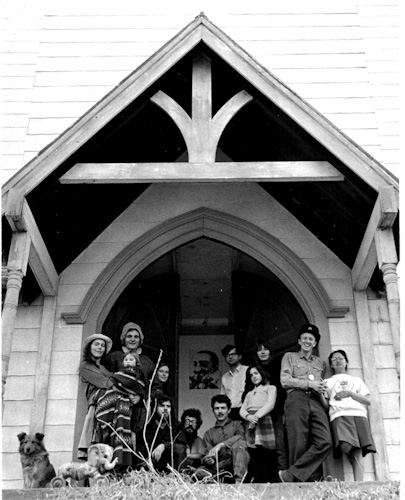Paige Rozanski
USCO: A Meditation on Technology and Mysticism and the Creation of a Psychedelic Aesthetic

USCO, Shiva, 1965, paint on canvas, electric lights, Avalon Fund, 2023.9.1
USCO (Company of US or US Company) was a group of artists, poets, filmmakers, engineers, and composers who formed a cooperative work and living space in a church in Garnerville, New York. They created multimedia, multisensory, ephemeral, environmental, and often immersive artworks featuring new communication apparatuses such as slide projectors, audiotapes, moving images, oscilloscopes, strobes, refracted lenses, and lasers. They foresaw the transformative power of media and enlisted technological tools as a conduit to expand consciousness. At the same time, USCO incorporated a philosophical framework to their practice that drew on visionary thinkers such as Marshall McLuhan, Buckminster Fuller, Meher Baba, and Ananda Coomaraswamy. Though well documented in media of the 1960s, USCO demands renewed attention; since 2007, when I was a graduate student at Columbia University, I have focused my scholarly pursuits on USCO through research, writing, and conducting oral histories. In 2019 I organized the program USCO: Films, Performance, and Conversation with 1960s Multimedia Pioneers at the National Gallery of Art, a rare multimedia performance resulting in a web feature featuring a short documentary.

USCO and friends at the Church in Garnerville, New York, April 1966, photograph. From left: Barbara and Steve Durkee (holding Dakota), Judi Wilson Stern, Chris George, Gerd Stern, Owen Jones, Michael Callahan, Radha Stern, Jane Burton, and Stewart and Lois Jennings Brand. Courtesy of Intermedia Foundation
My sabbatical fellowship has provided an opportunity to organize these materials, pursue additional threads of inquiry, visit the USCO Church and Special Collections at Stanford University, and write two articles. I have developed a more detailed and comprehensive time line summarizing an artistic practice that is, for several reasons, nebulous within the confines of art history. The first is that USCO has neither an official beginning nor ending. Participants were making works as early as fall 1963, but it wasn’t until 1964 that the name USCO came into being and 1965 when it was officially used in the press. USCO’s peak moment of production and media attention was 1965–1966 and, just as soon as they obtained notoriety, many individuals were already moving onto new endeavors. However, USCO made works into the late 1960s with inclusion in several museum exhibitions before slowly morphing, by 1969, into Intermedia Systems Corporation. The second reason is that USCO was a moniker used by a collective group of anonymous participants, in keeping with one of their mottos, “We Are All One.” Therefore, it is less about identifying who made what and more about expanding the narrative to include and follow the paths of the many participants who, before joining USCO and after their departure, often went on to enjoy illustrious careers beyond art history’s purview. Such diversity of creative and professional pathways necessitates interdisciplinary research. For example, Gerd Stern (b. 1928), a beat poet, and Michael Callahan (b. 1944), the first technical director of the San Francisco Tape Music Center, transitioned USCO into Intermedia Systems Corporation, and artist Steve Durkee (later Nooruddeen, 1938–2022) and Barbara Durkee (later Asha Greer, 1935–2022) founded the spiritual community Lama Foundation, which published Ram Dass’s seminal text, Be Here Now. At the same time, other participants, such as Stewart Brand (b. 1938), created the Whole Earth Catalog and Jud Yalkut (1938–2013) continued to make experimental films and videos throughout his career. One of my goals is to re-center the contributions of Barbara Durkee and Judi Wilson Stern (1938–2005) within the core group of Callahan, Steve Durkee, and Gerd Stern as they were instrumental in supporting USCO’s efforts through a silk-screen studio and the management of the Church’s living spaces. Additionally, a rotating cast of participants including Jonathan Ayers, Sara Ayers, Lois Jennings Brand, Barbara Budd, Jane Burton, Adrienne Callahan (b. 1944), Bob Dacey, Chris George, Owen Jones, Jim Kennedy, Judy Kennedy, Bob Kugler, Mary Orser, Brian Peterson, Paul Williams, and Dion Wright brought their own expertise and talents to the larger group.
During my sabbatical, I have worked on two articles which I hope to publish and eventually develop into a book. The first article, coauthored with Devin Lander, New York State Historian, discusses USCO’s collaboration with the Castalia Foundation on “Psychedelic Explorations,” a six-week series of workshops in 1965. Castalia was a group of researchers and academics, including Timothy Leary, Richard Alpert (later Ram Dass), and Ralph Metzner, who formed a psychedelic community at Millbrook, also located in the Hudson River valley. The article describes what took place and corrects previous historical accounts. It also lays the groundwork for a larger argument that this collaboration played a distinctive role in defining the psychedelic aesthetic that eventually made its way into mainstream culture. My second article will expand upon my initial research paper on USCO, providing an overview that examines the influences of technology and mysticism on their work through a focused discussion of a performance, commercial venture, and environment created in 1965–1966 in New York. My overall project aims to position USCO as central to the history of 1960s counterculture.
National Gallery of Art, Department of Modern and Contemporary Art
Ailsa Mellon Bruce National Gallery of Art Sabbatical Fellow, 2022–2023
Paige Rozanski is a curatorial associate in the Department of Modern and Contemporary Art at the National Gallery of Art. In the future, she plans to publish the two articles on USCO written during her sabbatical and develop them into a book proposal.
